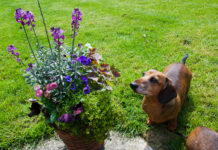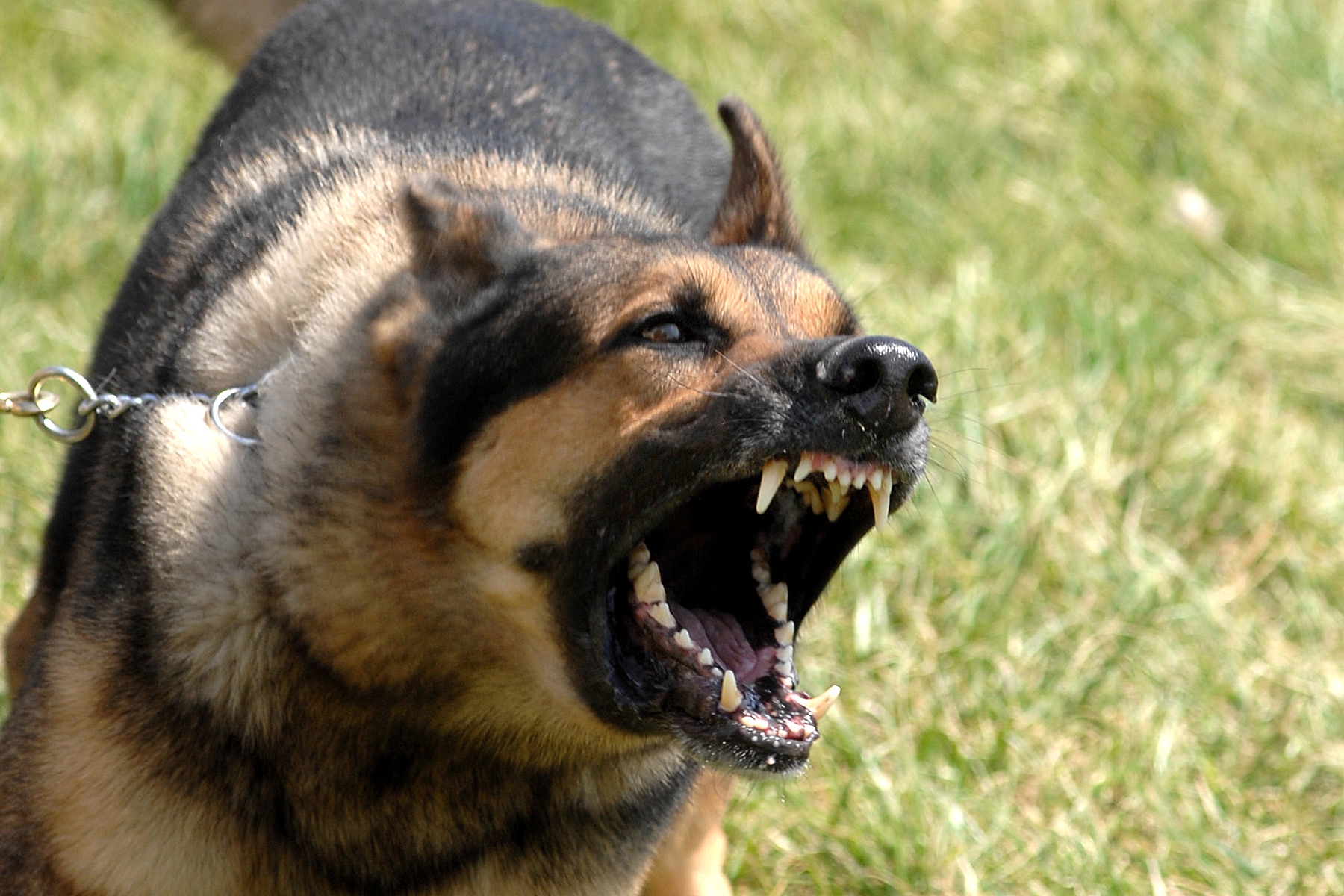Being confronted by large, unfamiliar, aggressive dogs, whether it’s the neighborhood “Houdini” whom manages to pull a vanishing act on his owners from time to time, a friend or family member’s new “home-guardian”, or that massive barking ball-of-fur standing in between you and your dog’s new chew toy at the local pet store, can be somewhat unsettling. In fact, depending on the dog and the situation, it can be downright scary.
Thankfully though, most interactions with stray or unknown aggressive dogs usually pass by without incident and actually are very friendly. There are those rare cases however, that can really bring about some very anxious moments of uncertainty, and/or pose a significant risk to yourself, and anyone or anything that may be with you.
Understanding Body Movements
The keys in preventing a serious attack are being able to read and understand the various signals aggressive dogs may be sending your way, and knowing which behaviors, on your part, can either provoke or prevent an attack. Being able to react properly can also help minimize the damage sustained if an attack somehow cannot be prevented.
Typical body positions or gestures for dogs that may be on the brink of attack can include, but are not limited to wide, firm, forward-looking body stances, barking and/or growling, pupil dilation, hackles raised (hair on neck and tail), ears erect and possible tail raising or wagging. It’s important to note that each dog will have it’s own unique characteristics for handling stressful or perceived threatening situations, and may not show all of the signs listed above.
Many people make the assumption that if a dog is wagging it’s tail, it’s indicating that he or she is friendly or means no harm. This is not always the case. Dogs carry their tails in many different ways for a variety of different reasons, and not all of them indicate friendship or lack of a cause for concern.
“A dog’s tail wagging is indicating that he is ready to act in some way, and it may or may not be friendly.”
For more explanations and visual interpretations of canine body language and aggression, check out our article on Watching Your Dog for Signs of Stress.
The first section of this article will discuss the proper protocols to follow when confronted by dogs whom you may be completely unfamiliar with, as well as those you may have seen before, however; have virtually no knowledge about. In part II, we’ll discuss how best to interact with those non-aggressive dogs you are very familiar with and consider trustworthy.
Aggressive Dogs – Imperfect Strangers
Dogs that are unknown present the biggest set of challenges when it comes to human confrontation. These issues stem from little or no knowledge of the dog’s temperament, mental or physical condition, and also, prior vaccination record. Stray dogs pose the greatest amount risk for this category due to the complete lack of historical data concerning previous aggression issues and communicable diseases.
“Therefore; it’s vitally important to proceed with caution with any stray or free-ranging dog, and to be mindful of the following points to help minimize the chances of being attacked.”
Do Not’s:
- Do not fight fire with fire. Acting aggressively towards aggressive dogs is likely only to incite an attack. Yelling, screaming, stomping feet, throwing objects, or antagonizing the dog in any way may cause a bad situation to get much worse by intensifying the dog’s aggression. Also be mindful of young children who may be fearful of large or unknown dogs and scream out of fear. The high pitches of a young child’s screeching may cause aggressive dogs to attack due to effects of being frightened by the sound.
- Do not stare the dog down directly or make persistent eye contact. Dogs can interpret eye contact as being threatening, which may provoke an already aggressive or frightened dog to attack.
- Do not square-off against fearful or aggressive dogs. This may be interpreted as an offensive position and could intensify the dog’s anger or fear. When greeting a strange dog, try to stand slightly to the side but always be mindful (without direct eye contact) of the dog’s position. By standing at a slight angle to the dog, you are sending him somewhat of a calming signal which indicates that you mean him no harm. Avoid abrupt movements.
- Avoid aggressively petting or wrestling when greeting unfamiliar dogs. Also never place your face near a strange dog’s mouth. Young children should especially be made to abide by these rules. They should also be taught to never place their face near the mouth of any dog, be it known or unknown.
- If possible, avoid approaching nervous, frightened or aggressive dogs. If you must approach, do so calmly and slowly and avoid approaching directly from the front, or from behind. Try to approach using an arc-like movement. Quick, deliberate movements directly toward aggressive dogs that are unsure of themselves can be viewed as threatening and make it appear as if they are about to be attacked. By moving in a slow, calm, arcing movement, the appearance of a possible threat is minimized.
- Do not run. This will more than likely trigger a chase response in the dog, and one in which the dog is likely to catch you. Unless you are 100% positive, beyond the shadow of a doubt, absolutely sure that you can make it to a safe location within a few steps, you must never, never run from a dog that has approached you. By doing so, you will also have to take your eyes off the dog. This is never a good idea.
- Never corner a fearful, nervous or agitated dog. By taking away all of dog’s options to escape from a stressful or frightening situation, it may feel it has no other chance for safety but to attack and defend itself. Aggressive dogs that are frightened or nervous should be left alone. This is especially true for young children.
- Do not tease a strange dog under any circumstance. This is especially true with food or toys.
Do’s:
- Always ask the owner (if one is present) if it’s safe to pet their dog. Public encounters with unfamiliar dogs should always be initiated by obtaining the owner’s permission to greet and pet the dog. This is imperative for young children. Young children should be encouraged not to play with strange dogs unless accompanied by a responsible owner, and must be taught to always ask permission before greeting any strange animal.
- Be mindful of a dog’s territory. Dog’s may become extremely defensive of their belongings and territory. If you encounter a strange dog, whom you know may be defending his or her home property, always proceed with caution. Try to walk another route or, if you must pass through the dog’s territory, do not do anything to incite further aggression. See item 1 in the DO NOT section above.
- Always be mindful of a strange dog’s location relative to yourself, especially those that seem aggressive or worrisome, by watching his movements and positions without making direct eye contact. Monitor the dog by using the corner of your eyes or looking at him without looking directly into his face or eyes.
- Try to stand tall but do not tower over aggressive dogs. Keep arms and hands down low by your side and keep your movements slow and smooth.
- If approached by aggressive dogs that seem dangerous, backup slowly without turning your back on the dog and as stated in number 3 above, always be mindful of the dog’s location and possible intentions. Talk calmly and smoothly to the dog only if it seems as if it may be helping the situation. If the dog intensifies in fear or anger, stop all communication. Move slowly and directly to a safe location. Avoid running or making abrupt movements.
- Always be mindful of your actions. Pet and greet strange dogs (with owner’s permission) in smooth, calm movements. Ask the owner if there are any areas the dog does and does not like to be touched and always obey the owner’s instructions.
- Young children should always refrain from touching or playing with dogs while the dog is eating or playing with a toy. This goes as well for when the dog is sleeping, nervous, frightened, isn’t feeling well due to an illness or being overexerted from the heat or strenuous activities.
- When greeting a dog, just keep your hands down by your side and let him sniff the back of your hand. Let the dog approach on his terms. Always be mindful of the owner’s instructions for petting. See number 6 above. Avoid petting or patting the top of the dog’s head. Unless otherwise instructed, pet the dog under the chin or on the belly and try to pet in the direction the fur is going.The dog will appreciate that much more than a few pats on the head. Always be mindful to keep your face or those of your children away from the dog’s mouth while petting him. Refrain from petting strange dogs that are fearful or are unsure of themselves.
What to Do if Attacked
- Do not incite further aggression by yelling or screaming. This may make matters worse. Remain silent and as calm as possible.
- Do not pull away from a dog that has bitten you. This is always very difficult to practice, because the first reaction is to try and pry, whichever part of the body the dog has bitten, loose from his mouth. Doing so can cause severe damage to that area, because the dog’s initial reaction is to tighten his jaws and pull in the opposite direction. The majority of damage sustained in dog bites is caused from trying to pull free of the dog’s bite.
- As difficult as it may be, try to remain as calm as possible. When the dog releases grip, try to follow all the points mentioned above to try to get away, as well the following.
- If escape is not possible, fall quietly to the ground, and, using your arms and hands, curl up into a ball to protect your head and face. You can also perform this procedure if you had fallen in the process of escaping from a threatening dog. Young children should become especially familiar with this position in the event they are attacked by aggressive dogs.
- If a child is attacked, the same rules apply with regards to trying to wrestle the child away from the dog. This is where the majority of damage can be caused. In this case, you need to resort additional measures to get the child to safety. Previous rules discussed here may need to be ignored. You need to get the dog’s attention away from the child; therefore, look for whatever you have at your disposal to accomplish this. If you have something you are able to throw over the dog or wrap around him, use it. If you are able to wet the dog with a hose or pale of water, do so. Remain quiet and calm in the process and instruct the child to assume the position described above. Do whatever you can to distract the dog and get the child to safety, without getting into a battle of strength with the dog.
Above all, the best advice to give when either approaching or being approached by unfamiliar or aggressive dogs is to use common-sense.
“If your instincts tell you that the dog isn’t to be trusted, then chances are, that’s what you should base all your decisions on, whether the owner tells you the dog is friendly or not.”
Always be mindful of young children and strange dogs. Before even asking whether or not a strange dog is friendly, perform your own assessment.
- How does the dog look?
- Does he appear nervous?
- Does he appear to be stressed, possibly from an illness or from some other external factor?
- Is he barking or growling or doing anything else that makes you feel uncomfortable?
Once you’ve done your own external evaluation and feel the dog is approachable, always ask the owner’s permission, and again decide for yourself if the dog is friendly or not. Children should never be forced to approach or pet a dog if they’re reluctant or scared.
Be mindful of the points discussed in this article and you’ll be better equipped to handle those rare and unfortunate encounters with a much more confident outlook. For more on handling and dealing with known or familiar dogs, see Aggressive Dogs – Part 2.














